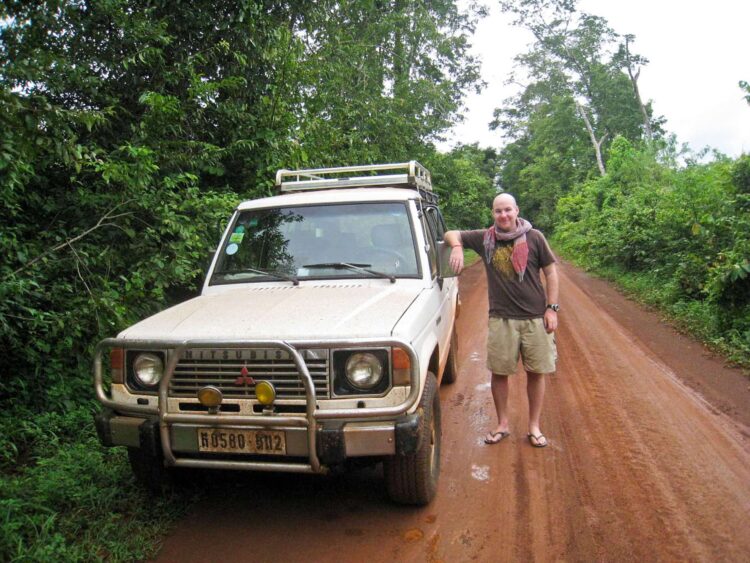
Dave on a 4×4 tour in Cambodia
I went with a different guide, who also operated the small internet shop next to the hotel.
He spoke better English and was offering the tour “at cost” meaning he would not be earning a profit. I don't know why.
My guide from the first day said such a move was designed to “destroy” him.
On my second day, I opted to hire a 4×4 to tour some local ethnic villages.
I felt bad, but as I had no one to share the cost with, the difference was sufficient for me to go with the lowest bidder.
I promised to buy my next bus ticket from the first guide, which he appreciated.

First, we stopped so I could pick up a new 2 gig SD memory card (my 5th).
Then, I asked to visit the bank, expecting to exchange traveler's checks, only to find an ATM.
It arrived in town a year ago, and I was ecstatic to find that in the last month, it had begun to accept Visa.
A fresh supply of dollars in hand, we set off on a 2-hour 4×4 ride past villages and into the jungle.
The first big obstacle was a detour through a stream.

The far end was the deep section, and we were under enough water for me to wonder whether my feet were about to get wet.
Thankfully, my driver handled it all like a pro, and the jeep never flinched (well, it did stall once over the 4-hour round trip).
Giant ruts from erosion and massive holes filled with muddy water hampered us the whole way.
I was glad to have sprung for the more costly truck over a motorbike.

The 45-minute boat ride upriver to the first ethnic village was great. Beautiful views.
On the subsequent boat legs of our journey, I made sure to sit in front.
The boat was so narrow, it felt as though one errant shift in weight would capsize us.

The first village was settled about 30 years ago after the Khmer Rouge was deposed.
It consisted of an ethnic minority of 300-400 Cambodians who practiced Animism, a belief system related to animal spirits.
The main draw which turned the village into a tourist destination was the unusual cemetery.
A lot of time and effort went into the rituals around death, and a lot of symbolism is used in the construction and placement of the graves.
My guide was careful to point out the exact spot where the buffalo are sacrificed. A few of their skulls hung on trees around the cemetery.

As we headed toward the boat, it began to rain, and we were able to wait it out in the home of one of the village elders.
My guide/driver also acted as an interpreter, so I was able to ask a few questions.
Back on the boat, we returned to the restaurant where we began, which overlooks the river.
There we ate lunch before heading off on a shorter 10-minute boat ride downriver to walk through Chinese and Lao villages.
The Chinese arrived after escaping the Japanese invasion during WWII. There were 25 families accounting for about 125 people.
When I noted the many stores selling cell phones, radios, etcetera, my guide responded that the Chinese were natural business people, and thus their village reflected the resulting wealth.

The adjacent Lao village stood in stark comparison. It was filled with farmers who sell rice to the Chinese and also buy from their shops.
The Lao people settled as a result of their proximity to Cambodia, and past warfare.
Dave is the Founder and Editor in Chief of Go Backpacking and Feastio. He's been to 66 countries and lived in Colombia and Peru. Read the full story of how he became a travel blogger.
Planning a trip? Go Backpacking recommends:
- G Adventures for small group tours.
- Hostelworld for booking hostels.

hotel spain
Wednesday 6th of May 2009
Another interesting article from your blog :) When will it stop....hopefully never
hotel spain
Wednesday 6th of May 2009
Another interesting article from your blog :) When will it stop....hopefully never